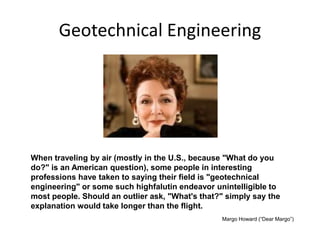Geotheta - The Facts
Geotheta - The Facts
Blog Article
The Main Principles Of Geotheta
Table of Contents7 Easy Facts About Geotheta ExplainedThe Ultimate Guide To GeothetaSee This Report about GeothetaGeotheta - Questions
They work together with civil engineers, structural designers, architects, and various other experts to incorporate geotechnical considerations into the total job style and building and construction procedure. This needs effective teamwork, coordination, and communication to make certain that the geotechnical aspects align with the task goals and meet governing requirements.Mining & Products Engineering: Principles of exploration, penetration prices, and variables influencing the choice of exploration technique. Characteristics of nitroglycerins, firing systems and blast patterns. Blasting techniques in surface and below ground operations. Unique blasting strategies at excavation borders. Vibration and sound control. Mechanical and continuous approaches to fragmentation, including longwall shearing and fullface boring.
Modelling of fragment and fragment dimension distributions; comminution as a transfer feature. Comminution technology: squashing, grinding, size category. Integrated analysis of fragmentation and comminution procedures. Supplied by: Mining & Products Engineering.
The Facts About Geotheta Uncovered
Bachelor's level programs in civil, geotechnical, geological, and environmental design commonly last 4 years and include basic education and learning training courses in English, social science, and the humanities, along with programs in innovative maths, architectural geology, and liquid mineralogy. (https://realistic-swam-lvtf1k.mystrikingly.com/blog/unlocking-the-secrets-of-geotechnical-engineers-the-geotheta-advantage)
Geotechnical design entails the analysis of the soil and rock problems at a certain site, and their effects for the growth of that site. As many frameworks rely upon the ground for support, it lacks shock that a comprehensive understanding of the ground problems, and the suitability of foundation systems, are essential to the long-lasting security and performance of the building or structure.
Specialising in the investigation of geological developments and ground practices, geotechnical engineers do scientific investigations and screening to recognize the effect these geological developments may carry the layout and construction of structure, civil and infrastructure projects. This knowledge is crucial for the layout and building and construction of buildings, roads, tunnels, dams, bridges, and water system and sewer system.
The geotechnical group at Douglas Allies routinely seek advice from with engineers, style engineers, designers, and contractors to make recommendations on layout and development propositions to guarantee that the constructed frameworks are appropriately created for the ground problems. For instance, the design of footing systems needs to think about the weight of the structure, the ability of the ground to support that weight along with movement tolerances and efficient building.
Geotheta - Questions
This job is greatly streamlined by the use our Douglas Map geospatial platform which makes this information easily obtainable in an easy to make use of internet browser interface. A geotechnical engineer will guide the drilling of boreholes and examination pits to gather soil and various other examples, and additionally assess surface attributes and ground exposures to create a geotechnical model of the subsurface problems.
Relying on the task kind and ground problems ran into, laboratory testing may to name a few points examine toughness, compressibility, reactivity and/or permeability of soil and rock examples. Hereafter information is collected and collated, the results are utilized for a geotechnical model of the site, which is commonly offered as sections throughout the website.

A geotechnical investigation naturally can only analyze the ground problems at the places pierced or navigate to this site excavated. Natural variants in dirt and rock problems can happen across a website and in between test areas. It is for that reason excellent method that the geotechnical designer be retained throughout building and construction of the task to offer on-site verification that the ground problems encountered are constant with the assumptions and guidance provided in the geotechnical examination record.
Some Ideas on Geotheta You Need To Know
Geotechnical designers use their extensive understanding of soil and rock to analyze risk and solve problems on varied framework projectsGeotechnical design is a specialist branch of civil engineering which considers the behaviour of earth materials and the application of soil and rock auto mechanics. Consulting Engineer. As a geotechnical designer, you will certainly examine the physical, mechanical and chemical residential or commercial properties of dirt and rock in order to design structures, maintaining structures and earthworks
Geotechnical design is carefully connected to and overlaps with, both design geology and ground engineering - https://www.imdb.com/user/ur185987626/?ref_=nv_usr_prof_2. It's possible to be experts in geotechnics or benefit a geotechnical company however be known as an engineering geologist or a ground engineer. As a geotechnical designer, you'll need to: construct and maintain partnerships with customers and other specialists included in the site, throughout each projectmaintain security standards on site be mindful of expense ramifications when you make recommendationsstudy geological maps and aerial photographs from an array of sources and from various time periodsexamine building and construction prepares to see just how possible they are based upon your understanding of the siteinvestigate risks or geological risks for the sitesearch for eco sensitive attributes, such as garbage dump start to develop factual and expository ground modelsplan area investigationsdrill and evaluate examples of bedrock, dirt, groundwater and additional products monitor various other experts on sitesolve technological problems as they arise, such as unanticipated frameworks at drill sitesmonitor conditions throughout and after building to ensure frameworks are steady in the short and long termadding information accumulated on website to your preliminary researchcreating geotechnical estimations, drawings, and 2 or three-dimensional computer system versions analyzing the datamaking recommendations concerning the proposed use the site

Report this page